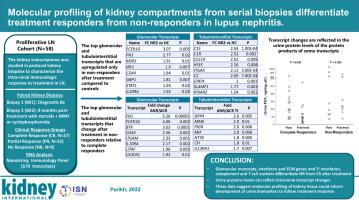Kidney International ( IF 14.8 ) Pub Date : 2022-07-02 , DOI: 10.1016/j.kint.2022.05.033 Samir V Parikh 1 , Ana Malvar 2 , Huijuan Song 1 , John Shapiro 1 , Juan Manuel Mejia-Vilet 3 , Isabelle Ayoub 1 , Salem Almaani 1 , Sethu Madhavan 1 , Valeria Alberton 4 , Celeste Besso 4 , Bruno Lococo 2 , Anjali Satoskar 1 , Jianying Zhang 1 , Lianbo Yu 1 , Paolo Fadda 1 , Michael Eadon 5 , Dan Birmingham 1 , Latha P Ganesan 1 , Wael Jarjour 1 , Brad H Rovin 1

|
The immune pathways that define treatment response and non-response in lupus nephritis (LN) are unknown. To characterize these intra-kidney pathways, transcriptomic analysis was done on protocol kidney biopsies obtained at flare (initial biopsy (Bx1)) and after treatment (second biopsy (Bx2)) in 58 patients with LN. Glomeruli and tubulointerstitial compartments were isolated using laser microdissection. RNA was extracted and analyzed by nanostring technology with transcript expression from clinically complete responders, partial responders and non-responders compared at Bx1 and Bx2 and to the healthy controls. Top transcripts that differentiate clinically complete responders from non-responders were validated at the protein level by confocal microscopy and urine ELISA. At Bx1, cluster analysis determined that glomerular integrin, neutrophil, chemokines/cytokines and tubulointerstitial chemokines, T cell and leukocyte adhesion genes were able to differentiate non-responders from clinically complete responders. At Bx2, glomerular monocyte, extracellular matrix, and interferon, and tubulointerstitial interferon, complement, and T cell transcripts differentiated non-responders from clinically complete responders. Protein analysis identified several protein products of overexpressed glomerular and tubulointerstitial transcripts at LN flare, recapitulating top transcript findings. Urine complement component 5a and fibronectin-1 protein levels reflected complement and fibronectin expression at flare and after treatment. Thus, transcript analysis of serial LN kidney biopsies demonstrated how gene expression in the kidney changes with clinically successful and unsuccessful therapy. Hence, these insights into the molecular landscape of response and non-response may help align LN management with the pathogenesis of kidney injury.
中文翻译:

通过连续活检对肾区室进行分子分析可区分狼疮性肾炎的治疗反应者和无反应者
定义狼疮性肾炎 (LN) 治疗反应和无反应的免疫途径尚不清楚。为了表征这些肾内通路,对 58 名 LN 患者的发作时(初次活检 (Bx1))和治疗后(第二次活检 (Bx2))获得的方案肾活检进行了转录组分析。使用激光显微切割分离肾小球和肾小管间质室。通过纳米线技术提取和分析 RNA,将 Bx1 和 Bx2 以及健康对照的临床完全应答者、部分应答者和无应答者的转录表达进行比较。通过共聚焦显微镜和尿液 ELISA在蛋白质水平上验证了区分临床完全应答者和无应答者的顶级转录本。在 Bx1 中,聚类分析确定肾小球整合素、中性粒细胞、趋化因子/细胞因子和肾小管间质趋化因子、T 细胞和白细胞粘附基因能够区分无应答者和临床完全应答者。在 Bx2 时,肾小球单核细胞、细胞外基质和干扰素以及肾小管间质干扰素、补体和 T 细胞转录物将无应答者与临床完全应答者区分开来。蛋白质分析鉴定了 LN 耀斑处过表达的肾小球和肾小管间质转录物的几种蛋白质产物,概括了顶部转录物的发现。尿液补体成分 5a 和纤连蛋白-1 蛋白水平反映了发作时和治疗后的补体和纤连蛋白表达。因此,连续 LN 肾活检的转录本分析证明了肾脏中的基因表达如何随着临床成功和不成功的治疗而变化。因此,这些对反应和无反应分子景观的见解可能有助于将 LN 管理与肾损伤的发病机制结合起来。











































 京公网安备 11010802027423号
京公网安备 11010802027423号